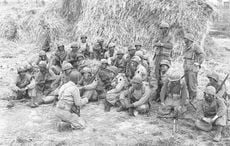This Sunday, the lives of two of Ireland’s greatest Republicans will be commemorated in Glasnevin Cemetery in a ceremony attended by Irish Ministers and members of the Irish Defense Forces.
Michael Collins and Arthur Griffith were two of the leading forces in the Irish War of Independence; Griffith as the acting President of the Dáil (Irish parliament) while Eamon de Valera traveled to the US to raise money, and Collins as Director of Intelligence for the Irish Republican Army and the founder of a special assassination unit called The Squad to expressly kill British agents and informers.
Both men traveled to England to treaty with the English government when a truce was called in 1921. Their negotiations eventually led to the signing of the Anglo-Irish Treaty which saw the establishment of the “Irish Free State” and the partition of Ireland into North and South.
They were the prominent advocates of the Treaty, despite Collins referring to his signing of the agreement to be akin to the signing his own death warrant, and they were the main political figures on the Pro-Treaty side of the Civil War that followed its implementation.
Fighting against their former allies, both men were to lose their lives during the course of the Civil War. Arthur Griffith died suddenly in August 1922, aged 50, which historians believe was due to overwork and stress, especially in the aftermath of the treaty negotiations, while Michael Collins was killed by anti-Treaty forces in Béal na mBláth in Co. Cork just a few days later. Both were buried in Glasnevin Cemetery following a public funeral.
Sun shines on Michael Collins #Glasnevin #LoveDublin pic.twitter.com/H2TohAUUfx
— Glasnevin Museum (@glasnevinmuseum) August 13, 2015
Griffith and Collins’ contribution to Irish history is still noted at their graveside. Although Collins was born in Cork, as the leader of the Irish Army at his death, he was laid to rest alongside all those who have died in service of the Irish armed forces while Griffith's own tombstone shows a broken pillar, a symbol that he set Ireland on the right path but wasn’t able to finish it as his life was cut short.
This weekend’s ceremony will remember their deaths, commemorating their heroic legacy in striving for Irish independence.
On display at the 93rd annual commemoration will be the Sliabh na mBan armored car, which formed part of the convoy involved in the ambush at Béal na mBláth in which Collins was killed.
Sliabh Na mBan armoured car at @ballinfestival, part of Michael Collins' convoy, ambushed at Béal Na mBláth in 1922. pic.twitter.com/SWLrC7mUdk
— Anne-Marie (@thecailinrua) July 8, 2015
The most iconic car in Irish history, Michael Collin's 'Sliabh na mBan' at @glasnevinmuseum today. pic.twitter.com/odhuSoO5ZP
— Stephen Browne (@Stephenbrow) August 17, 2014
The 1920s Rolls-Royce transported Collins’ body away from the scene of the ambush after he suffered a fatal gunshot wound to the head.
Ending up at at the army base at the Curragh Camp in Co. Kildare, the car was kept for years as “scrap” on the record but in fact, was being maintained by the cavalry workshop.
In 2011, the car was restored by the Defence Forces Combined Vehicle Base Workshop with help from Lisburn-based restoration experts.
While work was being carried out on the car, experts discovered a bullet mark in the armour which they believe dates back to the ambush.
The car was revealed by Enda Kenny in 2011, who referred to the vehicle as “silent witness” to one of the most devastating events in the Irish Civil War.
Collins/Griffith Commemoration takes place this Sunday 16 August at @glasnevinmuseum. @ConorPMBrady to give oration pic.twitter.com/dh7bEDuGNe
— William Lavelle (@LucanCouncillor) August 12, 2015
Although the car may not be able to relate the historic event it witnessed, he said, “it speaks to us, it shouts resistance, endurance, integrity, struggle and victory”.
The Griffth/Collins commemoration event is organized annually by the Collins/Griffith Commemoration Committee and Glasnevin Trust and is attended each year by Irish politicians.
This year, wreaths will be laid by Minister for Jobs Richard Bruton and Simon Harris, the Minister of State at the Department of Finance.
An oration will also be given by former editor of The Irish Times, Conor Brady, following a commemorative Mass at Berkeley Road church in Phibsborough in Dublin city.
Collins and Griffith are just two of the famous Republican names to be found in Glasnevin Cemetery.
Just this month marked the 100th anniversary of the death of Irish republican hero Jeremiah O’Donovan Rossa, whose death is believed to have ignited the spark that led to the 1916 Easter Rising.
Those who attended his funeral read like a list of all the major republican figures of the time and a famous oration given by Pádraig Pearse at the ceremony has been written into Irish history forever: “The fools, the fools, the fools! They have left us our Fenian dead, and while Ireland holds these graves, Ireland unfree shall never be at peace.”
O’Donovan Rossa. The centenary celebration is a reminder of the unfinished business of 1916. https://t.co/qkWKce52hX via @sharethis
— Gerry Adams (@GerryAdamsSF) August 10, 2015
Other names in the graveyard, established in 1832 by Irish political leader Daniel O’Connell, include Cathal Brugha, Countess Markievicz, Kitty Kiernan and Charles Stewart Parnell.




Comments